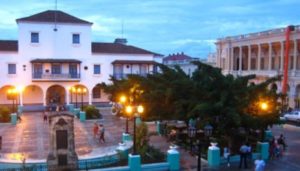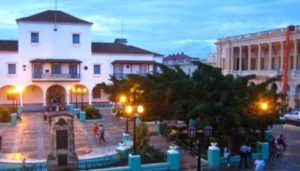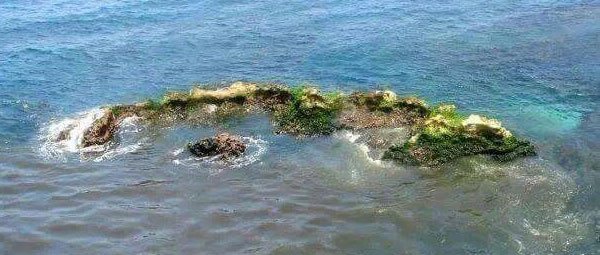EL CUMPLEAÑOS 505 DE SANTIAGO DE CUBA. SUS CALLES. PHOTOS.
Fundada hace 505 años, la ciudad de Santiago de Cuba fue una de las ocho primeras villas fundada por Diego Velazquez y la primera capital de la Isla hasta 1556. Nuestra ciudad atesora siglos de historia y tradiciones signada por el mestizaje reconocido por la Unesco, que le otorgó categorías patrimoniales a la primera plantación de café en el sudeste cubano y a la tumba francesa.
Dueña de estilos arquitectónicos que van desde el barroco más elemental hasta el neoclásico más refinado, sus calles nacieron del trazado de dos ejes direccionales: norte-sur y este-oeste y sus límites estaban, en el primer caso, en las iglesias de Santo Tomás y la de Santa Lucía.
El otro eje estuvo marcado por la iglesia de Santa Ana, más tarde la de Nuestra Señora de los Dolores, hasta el puerto situado en su hermosa bahía.
Así creció la urbanización de las viejas calles, llenas de fango en tiempos de fuerte lluvia y de polvo en época de seca.
Y tocó al Gobernador español Carlos de Vargas Machuca (1854-1860) el comienzo de los primeros arreglos de calles intransitables del centro histórico de la añeja urbe.
Luego de construidas las primeras aceras y, a partir de los ejes iniciales, como puntos de partida, se extendió la trama urbana. La calle de Santo Tomás fijó el eje norte-sur y la de las Enramaderas o Enramadas señaló el este-oeste.
Pero no es hasta 1881, que se colocaron las primeras tarjas de bronce con los nombres de las calles en las esquinas y se enumeraron las casas, reservándose los números pares para las aceras derechas y los impares para la zona izquierda.
Fueron los lugareños quienes dieron primeros nombres a esas vías, a partir de acontecimientos locales, de personas con cierta connotación y en los que no faltaron los sacados del santoral católico.
Posteriormente, en la república mediatizada las calles fueron bautizadas con nombres de patriotas o personalidades, así como también de hechos históricos.
No sería hasta finales del siglo XVIII y principios del XX, cuando Don Emilio Bacardí, primer alcalde electo por votación popular, empedrara las calles; la de Enramadas fue la primera en recibir los beneficios; posteriormente le siguieron las de Estrada Palma o Santo Tomás, Corona y parte de la Marina, actualmente Francisco Vicente Aguilera.
La emblemática calle Enramadas, la más comercial y transitada, exhibe el viejo esplendor de la ciudad, en medio de la modernidad que brindan los hoteles, cines y restaurantes.
En tanto, las legendarias y atractivas calles Padre Pico, Aguilera, Heredia, San Pedro y Calvario entre otras acogen una parte importante de la vida socio económica y cultural de la urbe.
Tres importantes avenidas: la de los Libertadores, la de los Desfiles y la Avenida de las Américas. Alrededor se halla el Complejo Monumental “General Antonio Maceo”, la llamada Plaza de la Revolución de Santiago completan el entramado urbano. Esta explanada acoge los principales eventos masivos de la ciudad y su diseño se inspira en la Protesta de Baraguá, durante la Guerra de Independencia que marcó el carácter rebelde de los cubanos. Sobresale la figura de Maceo a caballo, protagonista de dicha protesta. A su alrededor hay 23 machetes gigantescos, que recuerdan la principal arma de combate de los mambises durante las guerras de independencia; su número alude al reinicio de los enfrentamientos tras la Protesta de Baraguá, el 23 de marzo de 1878.
Y es precisamente del encantamiento de esas calles santiagueras provocado en el poeta español Federico García Lorca, que dejó constancia en los versos que le dedicó en el “Son a Santiago de Cuba” y la estrofa que reza: /Cuando llegue la luna llena/ Iré a Santiago de Cuba / Iré a Santiago/ En un coche de aguas negras/ Iré a Santiago/….
Esa es Nuestra Santiago, para todos los que vivimos hoy en sus calles y los que hemos tenido que salír de nuestra isla por pensar diferente de los que la gobiernan hoy, culpa de ellos, pero que siempre estará en nuestros corazones y en las generaciones futuras que sabrán poner en el lugar correcto, pero sin venganzas, todo lo que ha sido escondido y desterrado de nuestra hermosa herencia (AV).
SANTIAGO DE CUBA 505 BIRTHDAY. ITS STREETS. PHOTOS.
Founded 505 years ago, the city of Santiago de Cuba was one of the first eight towns founded by Diego Velazquez and the first capital of the Island until 1556, our city treasures centuries of history and traditions marked by the crossbreeding recognized by Unesco, which It gave patrimonial categories to the first coffee plantation in the Cuban southeast and to the French tomb.
Owner of architectural styles ranging from the most elementary baroque to the most refined neoclassical, its streets were born from the layout of two-directional axes: north-south and east-west and its limits were, in the first case, in the churches of Santo Tomás and that of Saint Lucia.
The other axis was marked by the church of Santa Ana, later that of Nuestra Señora de Los Dolores, to the port located in its beautiful bay.
Thus grew the urbanization of the old streets, full of mud in times of heavy rain and dust in the dry season.
And it touched the Spanish Governor Carlos de Vargas Machuca (1854-1860) the beginning of the first arrangements of impassable streets in the historic center of the old city.
After the first sidewalks were built and, from the initial axes, as starting points, the urban fabric was extended. Santo Tomás street fixed the north-south axis and that of las Enramaderas or Enramadas pointed east-west.
But it was not until 1881, that the first bronze plates with the names of the streets were placed in the corners and the houses were listed, reserving the even numbers for the right sidewalks and the odd ones for the left zone.
It was the locals who gave first names to these roads, based on local events, of people with a certain connotation and in whom there was no shortage of those taken from the Catholic saints.
Later, in the mediatized republic, the streets were baptized with the names of patriots or personalities, as well as historical facts.
It would not be until the end of the 18th century and the beginning of the 20th, when Don Emilio Bacardí, the first mayor elected by popular vote, paved the streets; that of Enramadas was the first to receive the benefits; Later they were followed by those of Estrada Palma or Santo Tomás, Corona and part of the Navy, currently Francisco Vicente Aguilera.
The emblematic Enramadas street, the most commercial and busy, exhibits the old splendor of the city, amid the modernity offered by hotels, cinemas, and restaurants.
Meanwhile, the legendary and attractive streets Padre Pico, Aguilera, Heredia, San Pedro, and Calvario, among others, host an important part of the socio-economic and cultural life of the city.
Three important avenues: that of the Liberators, that of the Parades and Avenida de las Américas. Around it is the Monumental Complex “General Antonio Maceo”, the so-called Plaza de la Revolución in Santiago complete the urban framework. This esplanade hosts the main massive events in the city and its design is inspired by the Baraguá Protest, during the War of Independence that marked the rebellious character of the Cubans. The figure of Maceo on a horse stands out, the protagonist of this protest. Around it is 23 gigantic machetes, which recall the main combat weapon of the Mambises during the wars of independence; their number alludes to the resumption of the confrontations after the Protest of Baraguá, on March 23, 1878.
And it is precisely the enchantment of those Santiago streets caused by the Spanish poet Federico García Lorca, who recorded in the verses that he dedicated to him in the “Son a Santiago de Cuba” and the stanza that reads: / When the full moon arrives / I will go to Santiago de Cuba / I will go to Santiago / In a black water car / I will go to Santiago /….
That is Our Santiago, for all of us who live on its streets today and those of us who have had to leave our island for thinking differently from those who govern it today, their fault, but that will always be in our hearts and in future generations that they will know how to put in the right place, but without revenge, everything that has been hidden and banished from our beautiful heritage (AV).
Agencies/ RHC/ Guadalupe Yaujar/ Maite González/ Internet Photos/ Arnoldo Varona (AV)/ www.TheCubanHistory.com
THE CUBAN HISTORY, HOLLYWOOD.

















